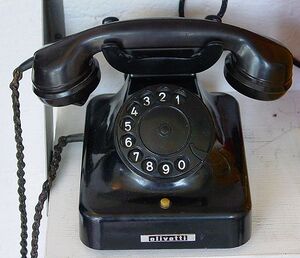Telephone (nonfiction): Difference between revisions
(Created page with "A '''telephone''', or '''phone''', is a telecommunications device that permits two or more users to conduct a conversation when they are too far apart to be heard directly. A...") |
No edit summary |
||
| (One intermediate revision by the same user not shown) | |||
| Line 1: | Line 1: | ||
A '''telephone''', or '''phone''', is a telecommunications device that permits two or more users to conduct a conversation when they are too far apart to be heard directly. A telephone converts sound, typically and most efficiently the human voice, into electronic signals suitable for transmission via cables or other transmission media over long distances, and replays such signals simultaneously in audible form to its user. | [[File:Rotary dial telephone.jpg|thumb|Rotary dial telephone made of bakelite.]]A '''telephone''', or '''phone''', is a telecommunications device that permits two or more users to conduct a conversation when they are too far apart to be heard directly. A telephone converts sound, typically and most efficiently the human voice, into electronic signals suitable for transmission via cables or other transmission media over long distances, and replays such signals simultaneously in audible form to its user. | ||
In 1876, Scottish emigrant [[Alexander Graham Bell (nonfiction)|Alexander Graham Bell]] was the first to be granted a United States patent for a device that produced clearly intelligible replication of the human voice. This instrument was further developed by many others. | In 1876, Scottish emigrant [[Alexander Graham Bell (nonfiction)|Alexander Graham Bell]] was the first to be granted a United States patent for a device that produced clearly intelligible replication of the human voice. This instrument was further developed by many others. | ||
| Line 21: | Line 21: | ||
== Fiction cross-reference == | == Fiction cross-reference == | ||
* [[Crimes against physical constants]] | |||
* [[Gnomon algorithm]] | |||
* [[Gnomon Chronicles]] | |||
== Nonfiction cross-reference == | == Nonfiction cross-reference == | ||
* [[Das Pferd frisst keinen Gurkensalat (nonfiction)]] - phrase spoken by [[Johann Philipp Reis (nonfiction)|Reis]] as demonstration of the Reis telephone | |||
* [[Alexander Graham Bell (nonfiction)]] | * [[Alexander Graham Bell (nonfiction)]] | ||
* [[Elisha Gray (nonfiction)]] | * [[Elisha Gray (nonfiction)]] | ||
* [[Johann Philipp Reis (nonfiction)]] | |||
External links: | External links: | ||
Latest revision as of 19:39, 15 April 2018
A telephone, or phone, is a telecommunications device that permits two or more users to conduct a conversation when they are too far apart to be heard directly. A telephone converts sound, typically and most efficiently the human voice, into electronic signals suitable for transmission via cables or other transmission media over long distances, and replays such signals simultaneously in audible form to its user.
In 1876, Scottish emigrant Alexander Graham Bell was the first to be granted a United States patent for a device that produced clearly intelligible replication of the human voice. This instrument was further developed by many others.
The telephone was the first device in history that enabled people to talk directly with each other across large distances. Telephones rapidly became indispensable to businesses, government, and households, and are today some of the most widely used small appliances.
The essential elements of a telephone are a microphone (transmitter) to speak into and an earphone (receiver) which reproduces the voice in a distant location. In addition, most telephones contain a ringer which produces a sound to announce an incoming telephone call, and a dial or keypad used to enter a telephone number when initiating a call to another telephone. Until approximately the 1970s most telephones used a rotary dial, which was superseded by the modern DTMF push-button dial, first introduced to the public by AT&T in 1963.
The receiver and transmitter are usually built into a handset which is held up to the ear and mouth during conversation. The dial may be located either on the handset, or on a base unit to which the handset is connected. The transmitter converts the sound waves to electrical signals which are sent through the telephone network to the receiving phone. The receiving telephone converts the signals into audible sound in the receiver, or sometimes a loudspeaker. Telephones permit duplex communication, meaning they allow the people on both ends to talk simultaneously.
The first telephones were directly connected to each other from one customer's office or residence to another customer's location. Being impractical beyond just a few customers, these systems were quickly replaced by manually operated centrally located switchboards. This gave rise to landline telephone service in which each telephone is connected by a pair of dedicated wires to a local central office switching system, which developed into fully automated systems starting in the early 1900s.
For greater mobility, various radio systems were developed for transmission between mobile stations on ships and automobiles in the middle 20th century. Hand-held mobile phones were introduced for personal service starting in 1973. By the late 1970s several mobile telephone networks operated around the world. In 1983, the Advanced Mobile Phone System (AMPS) was launched, offering a standardized technology providing portability for users far beyond the personal residence or office. These analog cellular system evolved into digital networks with better security, greater capacity, better regional coverage, and lower cost.
The public switched telephone network, with its hierarchical system of many switching centers, interconnects telephones around the world for communication with each other. With the standardized international numbering system, E.164, each telephone line has an identifying telephone number, that may be called from any authorized telephone on the network.
In the News
Fiction cross-reference
Nonfiction cross-reference
- Das Pferd frisst keinen Gurkensalat (nonfiction) - phrase spoken by Reis as demonstration of the Reis telephone
- Alexander Graham Bell (nonfiction)
- Elisha Gray (nonfiction)
- Johann Philipp Reis (nonfiction)
External links:
- Telephone @ Wikipedia
